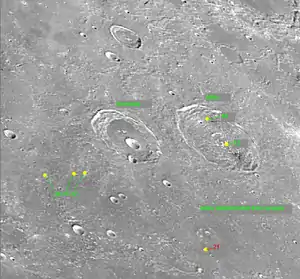Atlas (crater)
Atlas is a prominent lunar impact crater that is located in the northeast part of the Moon, to the southeast of Mare Frigoris. Just to the west is the slightly smaller but still prominent crater Hercules. Northeast of Atlas is the large crater Endymion.
 Mosaic of Lunar Orbiter 4 images | |
| Coordinates | 46.7°N 44.4°E |
|---|---|
| Diameter | 87 km |
| Depth | 2.0 km |
| Colongitude | 316° at sunrise |
| Eponym | Atlas |



The inner wall of Atlas is multiply terraced and the edge slumped, forming a sharp-edged lip. This is a floor-fractured crater with a rough and hilly interior that has a lighter albedo than the surroundings. Floor-fractures are usually created as a result of volcanic modifications.
There are two dark patches along the inner edge of the walls; one along the north edge and another besides the southeast edges. A system of slender clefts named the Rimae Atlas crosses the crater floor, and were created by volcanism. Along the north and northeastern inner sides are a handful of dark-halo craters, most likely due to eruptions. Around the midpoint is a cluster of low central hills arranged in a circular formation.
Atlas is a crater of Upper (Late) Imbrian age.[1]
The name Atlas was formally recognized by the IAU in 1935.[2]
Satellite craters
By convention these features are identified on lunar maps by placing the letter on the side of the crater midpoint that is closest to Atlas.
| Atlas | Latitude | Longitude | Diameter |
|---|---|---|---|
| A | 45.3° N | 49.6° E | 22 km |
| D | 50.4° N | 49.6° E | 25 km |
| E | 48.6° N | 42.5° E | 58 km |
| G | 50.7° N | 46.5° E | 23 km |
| L | 51.3° N | 48.6° E | 6 km |
| P | 49.6° N | 52.7° E | 27 km |
| W | 44.4° N | 44.2° E | 4 km |
| X | 45.1° N | 45.0° E | 5 km |
Exploration
The Atlas crater is the primary landing site of the Hakuto-R Mission 1 by ispace, scheduled to launch on December 7, 2022.[3] If successful, this mission could be the first private landing on the lunar surface,[4] and would be the first Japanese probe to land on the Moon. On April 25, 2023, Hakuto-R attempted to land, but suffered a communication failure with the spacecraft as it was landing. The failure is being investigated.[5]
References
- The geologic history of the Moon. USGS Professional Paper 1348. By Don E. Wilhelms, John F. McCauley, and Newell J. Trask. U.S. Government Printing Office, Washington: 1987. Table 11.2.
- "Atlas (crater)". Gazetteer of Planetary Nomenclature. USGS Astrogeology Research Program.
- "ispace". ispace-inc.com. Retrieved 2022-12-06.
- Crane, Leah (28 November 2022). "Japanese firm ispace is racing to put first private lander on the moon". New Scientist. Retrieved 2022-12-06.
- Sheetz, Michael. "Japanese ispace assumes attempted moon landing crashed, CEO says". CNBC. Retrieved 2023-04-25.
- Wood, Chuck (2005-04-03). "Atlas Alone". Lunar Photo of the Day. Archived from the original on 2006-05-14. Retrieved 2006-07-21.
- "SMART-1 image of crater Atlas". ESA/SPACE X. 2006-02-03. Retrieved 2006-09-20.
- Andersson, L. E.; Whitaker, E. A. (1982). NASA Catalogue of Lunar Nomenclature. NASA RP-1097.
- Blue, Jennifer (July 25, 2007). "Gazetteer of Planetary Nomenclature". USGS. Retrieved 2007-08-05.
- Bussey, B.; Spudis, P. (2004). The Clementine Atlas of the Moon. New York: Cambridge University Press. ISBN 978-0-521-81528-4.
- Cocks, Elijah E.; Cocks, Josiah C. (1995). Who's Who on the Moon: A Biographical Dictionary of Lunar Nomenclature. Tudor Publishers. ISBN 978-0-936389-27-1.
- McDowell, Jonathan (July 15, 2007). "Lunar Nomenclature". Jonathan's Space Report. Retrieved 2007-10-24.
- Menzel, D. H.; Minnaert, M.; Levin, B.; Dollfus, A.; Bell, B. (1971). "Report on Lunar Nomenclature by the Working Group of Commission 17 of the IAU". Space Science Reviews. 12 (2): 136–186. Bibcode:1971SSRv...12..136M. doi:10.1007/BF00171763. S2CID 122125855.
- Moore, Patrick (2001). On the Moon. Sterling Publishing Co. ISBN 978-0-304-35469-6.
- Price, Fred W. (1988). The Moon Observer's Handbook. Cambridge University Press. ISBN 978-0-521-33500-3.
- Rükl, Antonín (1990). Atlas of the Moon. Kalmbach Books. ISBN 978-0-913135-17-4.
- Webb, Rev. T. W. (1962). Celestial Objects for Common Telescopes (6th revised ed.). Dover. ISBN 978-0-486-20917-3.
- Whitaker, Ewen A. (1999). Mapping and Naming the Moon. Cambridge University Press. ISBN 978-0-521-62248-6.
- Wlasuk, Peter T. (2000). Observing the Moon. Springer. ISBN 978-1-85233-193-1.
External links
 Media related to Atlas (crater) at Wikimedia Commons
Media related to Atlas (crater) at Wikimedia Commons- Pyroclastic deposits in Atlas crater from USGS Astrogeology Science Center (Clementine 750-nm (albedo) data)
